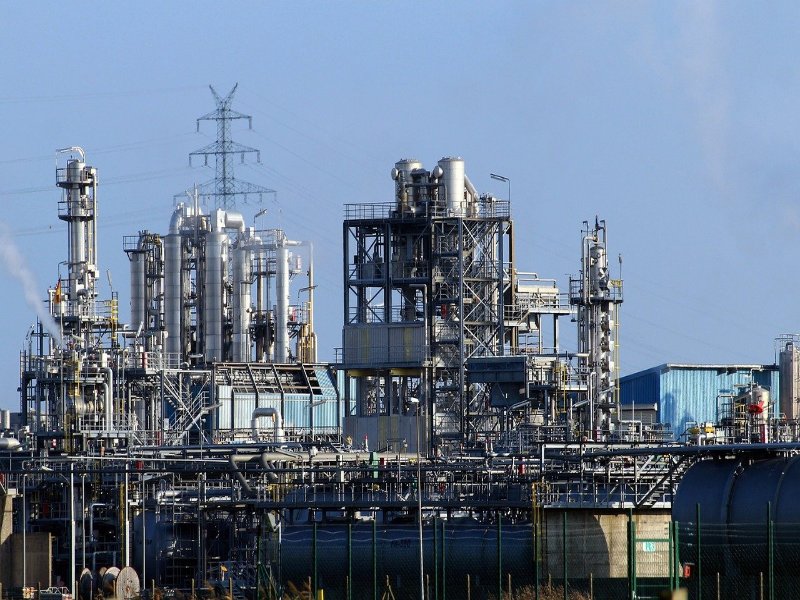Reliance Industries’ Jamnagar refinery is the largest refining hub in the world. The refinery and petrochemical complex is located at Jamnagar Manufacturing Division (JMD), at Motikhavdi Village, Jamnagar district in the Indian state of Gujarat.
The complex includes manufacturing as well as ancillary facilities such as offsites, utilities, port, township and other infrastructure facilities.
The Jamnagar refinery was commissioned in 1999. It processes an array of crude oils and produces petroleum products including liquefied petroleum gas (LPG), gasoline, propylene, naphtha, jet fuel, diesel, sulphur and petroleum coke.
Reliance commissioned another refinery within the Special Economic Zone at Jamnagar in 2008. This refinery has a crude processing capacity of 580,000 barrels per day (bpd).
Project Gallery
-

The Jamnagar Refinery has a crude processing capacity of 1.24 million Barrels Per Stream Day (BPSD). (Credit: Frauke Feind from Pixabay)
-

The Jamnagar Complex is spread over 7,500 acres. (Credit: tasukaran from Pixabay)
-

Reliance Industries’ Jamnagar refinery is the largest refining hub in the world. (Credit: Andrew Scheer/ Flickr)
The addition of the second refinery increased the capacity of the complex to 1.24 million barrels per stream day (bpsd).
The total cost of the project was around $6bn.
Location and site details
The project is situated on the northwest coast of India in the district of Jamnagar, which is surrounded by the Gulf of Kutch in the north, Rajkot district in the east, Junagadh district in the south and Devbhoomi Dwarka and the Arabian Sea in the east.
The refinery complex is around 815km from the city of Mumbai.
The complex features Fluidised Catalytic Cracker (FCC), Coker, Paraxylene, Alkylatio, Polypropylene, Refinery offgas (ROG) cracker and Petcoke gasification plants.
Overall, the entire complex includes an area of more than 7,500 acres.
Project Infrastructure
The Jamnagar complex was developed in less than three years.
It comprises interlinked clusters- Domestic Tariff Area or DTA Refinery, Gasification Complex, Petrochemical Complex, Special Economic Zone or SEZ Refinery, and associated utilities, offsites, and infrastructure facilities including access to a pipeline network.
The associated utilities include seawater intake and outfall facilities as well as seawater storage and treatment facilities. The complex also has integrated desalination and effluent treatment plants and a 2,880MW power plant to supply power to the refinery.
Gas turbines and steam turbine generators are used to generate power at the Captive Power Plant. Heat Recovery Steam Generators attached to turbines along with auxiliary boilers produce the steam required for plant usage.
Offsites include a Marine Tank Farm to support crude receipt and shipping of products. It also features a Refinery Tank farm to support operations and a Road/Rail Tank Farm will help in transporting refinery products.
Warehouses were built to store and dispatch products.
Infrastructure facilities include five Single Point Moorings (SPMs) to receive crude oil and export petroleum products. Six Liquid Jetty Berths were set up to help in the dispatch of products through associated pipelines. RO-RO and LO-LO jetties handle cargo, while onshore terminals store crude oil and products.
Operations
The site commenced operations in 1999 with an initial processing capacity of 18MMTPA of crude oil. The capacity was increased to 33MMTPA via value-product maximisation and debottlenecking.
After getting Environmental Clearance in 2005, an additional capacity of 26.7MMTPA was built to enhance the total refining capacity to 59.7MMTPA. Further expansions increased the capacity to 68.2MMTPA.
Refining process
The refinery complex consists of more than 50 process units to process basic feedstock and crude oil and deliver a range of products.
The major refining processes that are used include Crude oil distillation (Atmospheric as well as vacuum distillation), Catalytic cracking (Fluidised Catalytic Cracker), Catalytic reforming (Platforming) and Delayed Coking.
Contractors involved
US-based engineering company Bechtel was associated with the construction of the Jamnagar refinery. The company also built the second refinery that nearly doubled the facility’s capacity.
Tecon offers multidisciplinary basic and detailed design services during the Jamnagar Export Refinery Project (JERP).
Bright Engineers and Contractors won the contract for fabrication, welding testing, erection, and commissioning of DDFR tanks related to the JERP tankage project. The company was also associated with other structural works at the Jamnagar refinery including the delivery of MS Tanks and Cone Roof Tanks.
Konstelec Engineers Pvt. Ltd. (KEPL) carried out the installation, testing and commissioning of electrical and instrumentation works in multiple plants in Jamnagar.
URS Engineering Contractors helped in the erection of dome and other refinery equipment (air filter, ASU, agitator), and Circular Stacker Reclaimer.
Forays secured several annual instrumentation maintenance contracts and field installation works for the project.
Dextra was associated with Jamnagar refinery since the initial days and provided rebar splicing solutions, while Excel Tech Group carried out electrical and motor maintenance, and lighting works at the refinery site.
L&T supplied FCC Regenerators & Combustors for the Reliance project.
Piping installations in FCCU and Alkylation Units were done by Neo Structo Construction Pvt Ltd and Tarachandra Engineering offered manpower support for the fabrication of spools at PFS during the J3 project.
